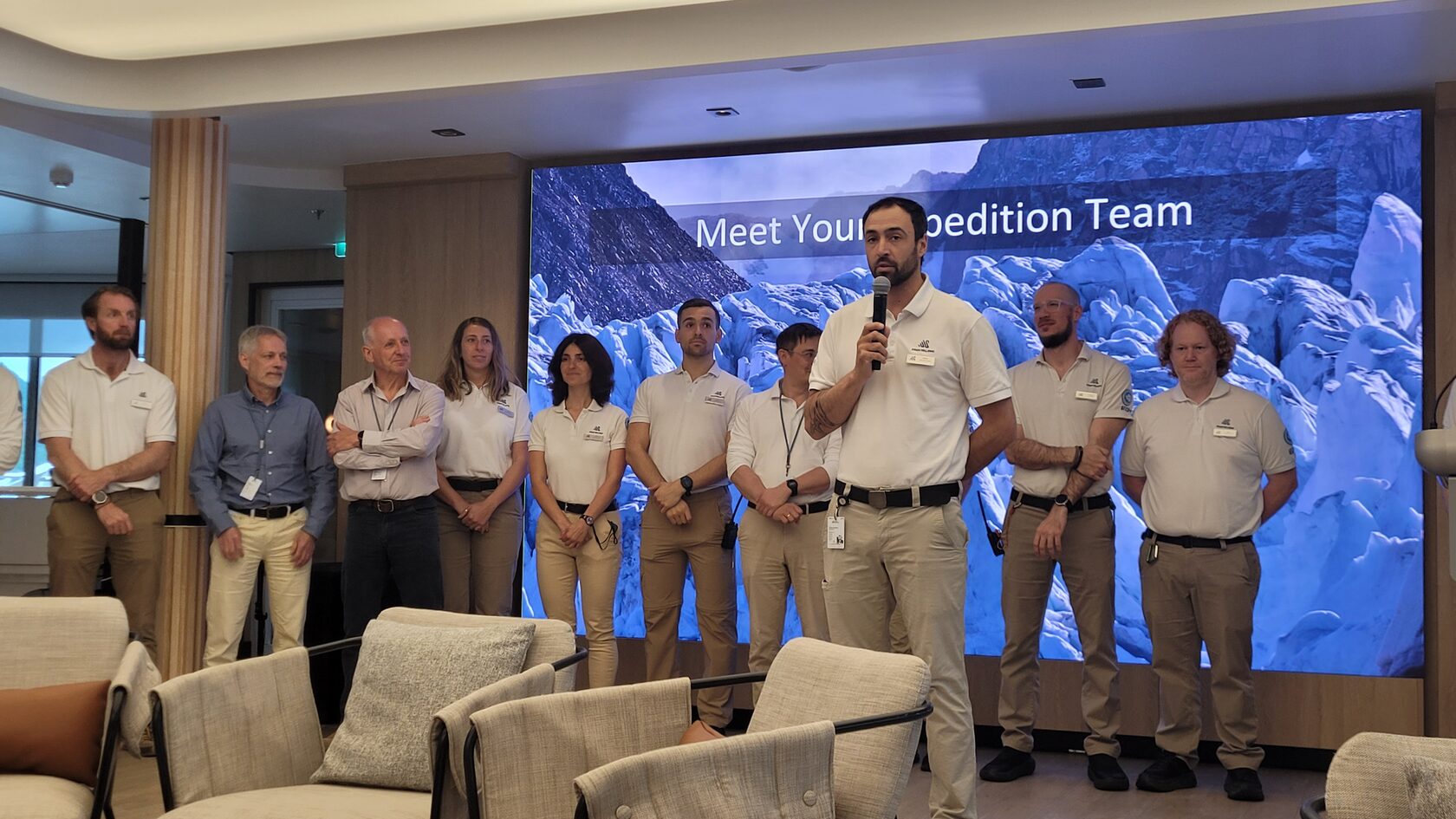
Natalia Kardash
My Trip to the Arctic -
Lifetime Adventure
Lifetime Adventure
Exploration Cruise to the Edge of the World
Some places don’t fit into typical travel plans. In July 2025, I set off to one of these places—beyond the Arctic Circle. I want to share this journey with you—not just the route and the photos, but the emotions, the discoveries, and those unforgettable moments. On this page you are reading my travel journal.
1
Overview of the Trip
My journey began in Larnaca and it took me through some of the most breathtaking and remote parts of the northern hemisphere. I’ll take you with me — step by step — as I move from city streets to icy fjords and polar silence.
My route started with a flight from Larnaca to Oslo, where I spent four days discovering Norway’s capital — a city where Scandinavian design meets Viking heritage, and fjords are just a tram ride away.
From Oslo, I went to Tromsø, the so-called gateway to the Arctic. I had just one day to explore this Arctic city — enough time to catch a breath before setting sail on the true highlight of the trip: an expedition cruise with Swan Hellenic.
For ten days, we went deep into the polar region on a ship designed for exploration and comfort. The cruise, titled Roundtrip cruise to the edge of the Arctic, circles around Spitsbergen, the largest island of the Svalbard archipelago. We navigated ice-filled waters, passed glaciers and dramatic cliffs, and encountered walruses, Arctic foxes, and even polar bears. Our program included landings, lectures, and scenes that feel almost unreal.
On the way home, the journey did not end abruptly. After returning to Tromsø, and walking for a few hours to explore the town a bit more, I had a flight to Copenhagen for one final Nordic morning walk before making my way back to Cyprus — with memories from the edge of the map.
This journal is not just about destinations — it’s about moments of wonder, stillness, and discovery. I hope you’ll join me in reliving this unforgettable experience.
My route started with a flight from Larnaca to Oslo, where I spent four days discovering Norway’s capital — a city where Scandinavian design meets Viking heritage, and fjords are just a tram ride away.
From Oslo, I went to Tromsø, the so-called gateway to the Arctic. I had just one day to explore this Arctic city — enough time to catch a breath before setting sail on the true highlight of the trip: an expedition cruise with Swan Hellenic.
For ten days, we went deep into the polar region on a ship designed for exploration and comfort. The cruise, titled Roundtrip cruise to the edge of the Arctic, circles around Spitsbergen, the largest island of the Svalbard archipelago. We navigated ice-filled waters, passed glaciers and dramatic cliffs, and encountered walruses, Arctic foxes, and even polar bears. Our program included landings, lectures, and scenes that feel almost unreal.
On the way home, the journey did not end abruptly. After returning to Tromsø, and walking for a few hours to explore the town a bit more, I had a flight to Copenhagen for one final Nordic morning walk before making my way back to Cyprus — with memories from the edge of the map.
This journal is not just about destinations — it’s about moments of wonder, stillness, and discovery. I hope you’ll join me in reliving this unforgettable experience.
«In the ice of the polar seas lies a world untouched, a realm of silence and light where nature still reigns in its purest form.»

When I told people I was joining an Arctic expedition cruise, the reaction was almost always the same – “Ah, going to see the polar bears?” But it’s not that simple.
In reality, seeing a polar bear in the wild is a rare privilege – and one that comes with strict rules. Cruise ships in Svalbard must now follow carefully regulated guidelines to protect both the bears and their fragile habitat. Tourists are not allowed to approach closer than 300 metres to a polar bear. That’s right – 300 metres is the minimum distance, and if a bear comes any closer, it’s the people who must move.Each group that sets foot on shore is escorted by armed guides – for safety. These guides are trained to keep both humans and bears out of trouble, sometimes firing flares if a bear wanders too close.
And here’s a fact that surprised me: polar bears are excellent swimmers – they can cover over 100 kilometres without stopping. So even if you’re on a remote island, you’re still in their territory. It’s a wild, unpredictable Arctic world – and we’re just visitors.
2
Tromsø:
Gateway to the Arctic
Gateway to the Arctic
Tromsø isn’t just a town – often it is called the Gateway to the Arctic. For centuries, it’s been the starting point for polar expeditions, and today, it’s a centre for the cruise industry, Arctic research and world-class seafood production.
Tromsø’s port welcomes expedition cruise ships that head deep into the icy Svalbard, Greenland, and even the North Pole. The city’s maritime culture is alive and thriving – not just with tourism, but with the historic and modern traditions of fish hunting, drying, and export. Cod and king crab from these cold waters are prized around the world, and Tromsø’s economy pulses with the rhythm of the sea.
Tromsø’s port welcomes expedition cruise ships that head deep into the icy Svalbard, Greenland, and even the North Pole. The city’s maritime culture is alive and thriving – not just with tourism, but with the historic and modern traditions of fish hunting, drying, and export. Cod and king crab from these cold waters are prized around the world, and Tromsø’s economy pulses with the rhythm of the sea.
“Tromsø is the last outpost of civilisation before the vast wilderness of the Arctic.”
I was travelling with my son Alex, and it was interesting to compare thoughts and impressions of two generations. We began our Arctic journey in Tromso, and naturally, started with Polaria. This modern building, shaped like ice floes pressed against the shore, offers interactive exhibits about sea ice, northern wildlife, and climate change. The bearded seals in the aquarium are captivating, but even more moving is the panoramic film that takes you over Svalbard’s glaciers and icy peaks – a breathtaking preview of what lies north.
Two fascinating facts about seals:
1. Seals can sleep underwater – and even while swimming.
Seals have the incredible ability to shut down parts of their brain while resting, allowing them to sleep underwater without drowning. Some species use a technique called unihemispheric slow-wave sleep, where one half of the brain sleeps while the other remains alert enough to surface for air or watch for predators.
2. Bearded seals sing complex songs under the ice.
In Arctic waters, male bearded seals produce melodic songs to attract mates – and their vocalisations can travel for tens of kilometres through the ice-covered sea. These underwater "concerts" are among the most sophisticated vocal displays in the animal kingdom, and can be heard through hydrophones by scientists studying polar ecosystems.
Two fascinating facts about seals:
1. Seals can sleep underwater – and even while swimming.
Seals have the incredible ability to shut down parts of their brain while resting, allowing them to sleep underwater without drowning. Some species use a technique called unihemispheric slow-wave sleep, where one half of the brain sleeps while the other remains alert enough to surface for air or watch for predators.
2. Bearded seals sing complex songs under the ice.
In Arctic waters, male bearded seals produce melodic songs to attract mates – and their vocalisations can travel for tens of kilometres through the ice-covered sea. These underwater "concerts" are among the most sophisticated vocal displays in the animal kingdom, and can be heard through hydrophones by scientists studying polar ecosystems.
Then we visited the Blue Vision Expo, and were lucky to talk to an inspiring woman who told us about new fish growing technologies. It’s not just about fishing – it’s about protecting the ocean for generations to come.
1. Salmon start their life in fresh water – and finish in the sea.
Atlantic salmon are raised in freshwater hatcheries for the first 12–18 months of their life. Once they reach a certain stage (called smoltification), they are transferred to seawater pens where they continue to grow. This mirrors their natural life cycle and helps ensure healthy development.
2. Norway is the global leader in salmon farming – and Tromsø is one of its key innovation hubs.
Norway produces over 50% of the world’s farmed Atlantic salmon, and much of the industry’s technological development – including automated feeding systems, underwater sensors, and fish health monitoring – is driven by research centres based in and around Tromsø.
3. New technologies allow to record every day of fish life before it goes to the market.
From land-based closed-containment systems (which recycle 99% of water) to AI-powered feeding that reduces waste, the industry is shifting fast. Some farms use lasers to control the health of their fish and monitor their cages with dozens of underwater cameras in 24/7 regime.
1. Salmon start their life in fresh water – and finish in the sea.
Atlantic salmon are raised in freshwater hatcheries for the first 12–18 months of their life. Once they reach a certain stage (called smoltification), they are transferred to seawater pens where they continue to grow. This mirrors their natural life cycle and helps ensure healthy development.
2. Norway is the global leader in salmon farming – and Tromsø is one of its key innovation hubs.
Norway produces over 50% of the world’s farmed Atlantic salmon, and much of the industry’s technological development – including automated feeding systems, underwater sensors, and fish health monitoring – is driven by research centres based in and around Tromsø.
3. New technologies allow to record every day of fish life before it goes to the market.
From land-based closed-containment systems (which recycle 99% of water) to AI-powered feeding that reduces waste, the industry is shifting fast. Some farms use lasers to control the health of their fish and monitor their cages with dozens of underwater cameras in 24/7 regime.
«The difficult is what takes a little time. The impossible is what takes a little longer.»
Polar Museum
The quote above is a good introduction to the history of Arctic. We were impressed with the Polar Museum of Tromsø - it illustrates it very well. I recommend anyone who'll visit the town to go there: the history of Arctic exploration will be unfolded layer by layer.

Life on the Edge of the World
A Brief History of Arctic Exploration
The Arctic has fascinated and challenged humanity for thousands of years. The first people to settle in these harsh regions were the Paleo-Inuit and later the Thule people, ancestors of modern Inuit. They mastered life in the ice, hunting seals and whales using ingenious tools and deep knowledge of the land and sea.
About 500 years ago, European nations began sending expeditions in search of the fabled Northwest Passage – a route to Asia through the Arctic. Many ships became trapped in ice. Some, like the tragic Franklin Expedition (1845), were lost forever. But the age of Arctic exploration had begun.
In the 18th and 19th centuries, Russian explorers and hunters expanded into the Arctic from Siberia, discovering and mapping parts of Novaya Zemlya, Franz Josef Land, and later the Svalbard archipelago (known to Russians as Шпицберген). They established seasonal hunting huts and overwintered in brutal conditions to trap Arctic foxes and polar bears for valuable pelts.
By the early 20th century, the Russian presence began to fade. Norwegian trappers, scientists, and polar heroes like Roald Amundsen and Fridtjof Nansen took the lead. Norway gradually established stronger sovereignty over Svalbard, especially after the Svalbard Treaty of 1920, which recognised Norwegian authority while allowing other nations, including Russia, to continue economic activity.
The Arctic has fascinated and challenged humanity for thousands of years. The first people to settle in these harsh regions were the Paleo-Inuit and later the Thule people, ancestors of modern Inuit. They mastered life in the ice, hunting seals and whales using ingenious tools and deep knowledge of the land and sea.
About 500 years ago, European nations began sending expeditions in search of the fabled Northwest Passage – a route to Asia through the Arctic. Many ships became trapped in ice. Some, like the tragic Franklin Expedition (1845), were lost forever. But the age of Arctic exploration had begun.
In the 18th and 19th centuries, Russian explorers and hunters expanded into the Arctic from Siberia, discovering and mapping parts of Novaya Zemlya, Franz Josef Land, and later the Svalbard archipelago (known to Russians as Шпицберген). They established seasonal hunting huts and overwintered in brutal conditions to trap Arctic foxes and polar bears for valuable pelts.
By the early 20th century, the Russian presence began to fade. Norwegian trappers, scientists, and polar heroes like Roald Amundsen and Fridtjof Nansen took the lead. Norway gradually established stronger sovereignty over Svalbard, especially after the Svalbard Treaty of 1920, which recognised Norwegian authority while allowing other nations, including Russia, to continue economic activity.
This powerful display from the Polar Museum in Tromsø captures the raw, unforgiving reality of early Arctic life. Inside a hut, surrounded by furs, fish, and handmade tools, mannequins portray trappers and explorers who once braved the polar frontier with little more than resilience and instinct.
The man splitting wood is not preparing for comfort – he's preparing to survive. His companion sits in silence, wrapped in worn layers, with a distant look that speaks of months in solitude and darkness. Behind them, the spoils of the hunt hang drying: seal pelts, bird carcasses, and the skeletal remains of Arctic prey – every piece a testament to survival, not luxury.
This is not romanticised exploration – this is the truth of life in the polar north. No electricity. No safety. Just man, nature, and the vast silence of the Arctic.
The man splitting wood is not preparing for comfort – he's preparing to survive. His companion sits in silence, wrapped in worn layers, with a distant look that speaks of months in solitude and darkness. Behind them, the spoils of the hunt hang drying: seal pelts, bird carcasses, and the skeletal remains of Arctic prey – every piece a testament to survival, not luxury.
This is not romanticised exploration – this is the truth of life in the polar north. No electricity. No safety. Just man, nature, and the vast silence of the Arctic.
«The frozen lands are a mirror of the soul. Those who dare to look into it will discover their true self.»
3
Swan Hellenic Exploration Ship SH Diana
We travelled from Larnaca to Oslo, then to Tromsø, with the aim to board SH Diana and spend 10 days exploring the Arctic. Passengers come on the pre-cruise day, walk around Tromsø, stay overnight in the hotel arranged by Swan Hellenic. When we woke up, this was our view:

SH Diana in Tromsø Port
The SH Diana, part of Swan Hellenic’s expedition fleet, is ice-strengthened and fitted with a hybrid diesel-electric propulsion system. This way it implements zero-emission battery power for silent navigation in sensitive regions.
Equipped with a dedicated expedition lab, marine-life library, and Zodiac and kayak fleet, Diana also includes a multifunctional lecture theatre and “Citizen Science” initiatives, encouraging guests to actively participate in ongoing polar research.
We had 71 travellers on board and a team of 127 people. I took interviews from the captain, the hotel director, the expedition leader, scientists and guides. I collected information and enjoyed the trip and personal communication with expedition team. It is impressive that waiters and other ship personel address passengers by name: within the first two days they managed to remember everyone.
Equipped with a dedicated expedition lab, marine-life library, and Zodiac and kayak fleet, Diana also includes a multifunctional lecture theatre and “Citizen Science” initiatives, encouraging guests to actively participate in ongoing polar research.
We had 71 travellers on board and a team of 127 people. I took interviews from the captain, the hotel director, the expedition leader, scientists and guides. I collected information and enjoyed the trip and personal communication with expedition team. It is impressive that waiters and other ship personel address passengers by name: within the first two days they managed to remember everyone.
Interview with Hotel Director Mauricio dos Santos
Mauricio dos Santos: “If you’ve come to the Arctic — don’t sleep through it. Live every single moment!”
Meet the Team
Natalia with the SH Diana's Captain and Alex with the Restaurant Manager

Swan Hellenic Diana's Captain Team

Swan Hellenic Diana's Expedition Team
I’ve been on cruises before — it’s my favourite way to travel. But the summer expedition with Swan Hellenic was more than just a chance to “see the edge of the world” with my own eyes. It introduced me to a different kind of journey — inspiring expedition cruises where the focus isn’t just on relaxation, but on deep immersion into the nature and culture of remote, uncharted regions.
In summer, the Arctic is ruled by the polar day — the sun never dips below the horizon, and time itself seems to stand still. It’s a strange and yet mesmerising feeling: you lose all sense of time and find yourself in a state of constant wakefulness and curiosity.
In summer, the Arctic is ruled by the polar day — the sun never dips below the horizon, and time itself seems to stand still. It’s a strange and yet mesmerising feeling: you lose all sense of time and find yourself in a state of constant wakefulness and curiosity.
On Deck 7, at the aft of the ship
Departing Tromso. Our first hours at sea. It is a good chance to meet the team members and talk about the program. I was so absorbed by everything around me that I barely noticed how quickly I adapted to this special way to travel.
Interview with Expedition Leader Rayann Elzein
Rayann Elzein: “I once came to see the Northern Lights — and fell in love with the Arctic”
4
First Zodiac Cruise
Bear Island (Bjørnøya) is the southernmost island of the Svalbard archipelago, located halfway between mainland Norway and Spitsbergen. Covering an area of approximately 178 square kilometres, it is remote, windswept, and mostly uninhabited—apart from a staffed Norwegian weather and research station. The island was discovered in 1596, by Dutch explorers Willem Barentsz and Jacob van Heemskerk during their quest for the Northeast Passage. They named it Bear Island after encountering a polar bear swimming near the island’s coast—a rare sight that left a lasting impression. Today, Bear Island is a nature reserve, known for its dramatic cliffs teeming with seabirds, its harsh weather, and its strategic location in the Barents Sea. Despite its name, polar bears are seldom seen here—it’s the birds that truly rule the skies.
5
First Landing: Walruses and Polar Raindeers
Cape Lee is a wild and windswept headland on the eastern coast of Edgeøya, one of the larger islands in the Svalbard archipelago. Remote and rarely visited, this rugged place is home to thriving walrus haul-outs along the shore and Svalbard reindeer grazing the tundra. Towering cliffs, weathered rocks, and icy winds create a dramatic Arctic scene where wildlife and solitude reign.
6
Alex' Birthday on Board
Alex celebrated his 22nd birthday en route to the very edge of the Arctic. The ship’s crew arranged several lovely surprises for him, and it was an absolute pleasure to mark the occasion on board.
A birthday to remember – in truly extraordinary surroundings.
A birthday to remember – in truly extraordinary surroundings.
7
Exciting Experience: Kayaking in the Arctic Ocean
I was truly frightened – all due to my hyper-responsibility. I had never sat in a kayak before, and we had to paddle around 3 kilometres. But what worried me most was the moment I would have to transfer from the rubber boat into the kayak. Surely, I’d flip it out of fear and inexperience! Into the Arctic Ocean! And with my own son on board, no less!
Then it was time to go. We were dressed in ultra-modern waterproof suits. You can’t manage them on your own – like a spacesuit, you have to climb into it from the back, with the zip fastening behind you. Underneath, I had three layers of thermal clothing – we were going to sit just above the water for two hours. It was quite a clumsy and restrictive setup. Over it all came the life jacket: five kayaks would go a fair distance from the ship. But a rescue boat followed us – just in case. So everyone would be saved, if needed.
Then it was time to go. We were dressed in ultra-modern waterproof suits. You can’t manage them on your own – like a spacesuit, you have to climb into it from the back, with the zip fastening behind you. Underneath, I had three layers of thermal clothing – we were going to sit just above the water for two hours. It was quite a clumsy and restrictive setup. Over it all came the life jacket: five kayaks would go a fair distance from the ship. But a rescue boat followed us – just in case. So everyone would be saved, if needed.

How to fight your fears in a plastic boat in the Arctic Ocean?
But you know what? If you can overcome your fear, pull yourself together, and focus – the impossible becomes possible. For the first fifteen minutes in the kayak, I was simply trying to process the fact that Alex and I were steering this small plastic vessel in the Arctic Ocean. 300 metres from the shore, and already a kilometre away from the ship. But gradually, the mesmerising views took over my attention. Towering cliffs. Thousands of birds flying above our heads. One stunning scene after another – a waterfall, a glacier, and, suddenly, a patch of green meadow nestled between the rocks.

First selfie
Interview with kayak instructor Alexis Navarro
Alexis Navarro: “I Cannot Fly, but in the Arctic I Feel Like a Bird”
8
Svalbard – an Arctic Biodiversity Hotspot

Polar bear, Arctic fox, Svalbard reindeer on land. Whales, seals, walruses and 120 species of fish in the sea. 40 breeding bird species in air.
- Despite its extreme environment, Svalbard is home to 21 species of mammals – just 3 on land (like the polar bear, Arctic fox, and Svalbard reindeer), but 18 marine mammals, including whales, seals, and walruses.
- The archipelago hosts over 40 breeding bird species, thriving in the summer months thanks to 24-hour daylight and abundant food.
- Svalbard's waters are rich with life: 120 species of fish swim in these Arctic seas, alongside thousands of invertebrate species that form the base of the food chain.
Interview with zoologist and guide Liya Pokrovskayia
Liya Pokrovskaya: On Becoming an Arctic Zoologist
9
Lectures on Board: Knowledge is Power
Every day team members delivered lectures that gave us much information about the places we were visiting. It is an extreemely important element of an exploration journey. I'll try to share with you the most memorable facts I learned.
Interview with guest lecturer and guide Mark Evans
Under the Arctic Moon: The Extraordinary Trips of Mark Evans
What is the Arctic?
There are four ways to answer this question. The easiest - from the point of geography. But you may also consider a political map of the Arctic, an enviromental map, tree/forest line...
Interview with historian and guide Artem Rabogoshvili
Artem Rabogoshvili: “I reached the North Pole by accident — but stayed in the Arctic for good”

A Vanishing White World
When the ice will disappear?
The image tells a powerful story — one of a rapidly changing Arctic.
On the left, the year 1984: Arctic sea ice stretches across 6.7 million square kilometres (2.59 million square miles) at the end of summer, cloaking the polar ocean in a vast, white shield that reflects sunlight and helps stabilise the planet’s climate.
On the right, just 28 years later, in 2012: the same summer snapshot reveals a dramatically diminished Arctic, with sea ice shrinking to just 3.41 million square kilometres (1.32 million square miles). That’s a loss of nearly half the summer ice cover — an area larger than India.
The ice is not only retreating — it’s thinning. Older, multi-year ice that once formed a resilient core is vanishing, replaced by fragile seasonal ice that melts away with alarming speed. This isn’t just about polar bears losing habitat — though they are. It’s about rising sea levels, changing weather patterns, and the disruption of entire ecosystems. The Arctic acts as Earth’s air conditioner. As it melts, the world warms.
Scientists warn that if current trends continue, the Arctic could be ice-free in summer by 2035-2040.
The image tells a powerful story — one of a rapidly changing Arctic.
On the left, the year 1984: Arctic sea ice stretches across 6.7 million square kilometres (2.59 million square miles) at the end of summer, cloaking the polar ocean in a vast, white shield that reflects sunlight and helps stabilise the planet’s climate.
On the right, just 28 years later, in 2012: the same summer snapshot reveals a dramatically diminished Arctic, with sea ice shrinking to just 3.41 million square kilometres (1.32 million square miles). That’s a loss of nearly half the summer ice cover — an area larger than India.
The ice is not only retreating — it’s thinning. Older, multi-year ice that once formed a resilient core is vanishing, replaced by fragile seasonal ice that melts away with alarming speed. This isn’t just about polar bears losing habitat — though they are. It’s about rising sea levels, changing weather patterns, and the disruption of entire ecosystems. The Arctic acts as Earth’s air conditioner. As it melts, the world warms.
Scientists warn that if current trends continue, the Arctic could be ice-free in summer by 2035-2040.
Before and after
These pairs of photos from Svalbard glaciers do not need explanation...
These are our photos of glaciers
They are made by smart phones - by Alex and me. We wanted to memorise these landscapes. Most probably we have only 10-15 years left to see this summer beauty - when the sun shines, white glaciers are reflected in the ocean.
Interview with Assistant of the Expedition Leader Alena Antonova
Alena Antonova: From Yoga Instructor to Polar Guide
10
For a brief moment, we were the northernmost people on Earth
11
Ny-Ålesund – The World’s Northernmost Research Town
Once a coal mining settlement, today Ny-Ålesund is an international research station, hosting scientists from more than 10 countries year-round. Norway, Germany, France, the UK, Japan, South Korea, India, China, and others operate stations here, studying climate change, glaciology, atmosphere, ecosystems, and Arctic wildlife.
Because of its clean, undisturbed air, Ny-Ålesund is also a key site for atmospheric research and part of global climate observation networks. It’s a place where science meets silence — no cars, no distractions, just data, sky, and snow.
But Ny-Ålesund is not only about the future. It also holds a place in the bold past of polar exploration. In 1926, Italian explorer Umberto Nobile and Norwegian hero Roald Amundsen departed from here in the airship Norge — one of the first successful flights over the North Pole. The mast where the airship was moored still stands, weathered by time and wind — a quiet reminder of the age of heroic exploration.
Today, Ny-Ålesund remains a place few can visit — access is strictly limited to researchers and select guided visits.
Because of its clean, undisturbed air, Ny-Ålesund is also a key site for atmospheric research and part of global climate observation networks. It’s a place where science meets silence — no cars, no distractions, just data, sky, and snow.
But Ny-Ålesund is not only about the future. It also holds a place in the bold past of polar exploration. In 1926, Italian explorer Umberto Nobile and Norwegian hero Roald Amundsen departed from here in the airship Norge — one of the first successful flights over the North Pole. The mast where the airship was moored still stands, weathered by time and wind — a quiet reminder of the age of heroic exploration.
Today, Ny-Ålesund remains a place few can visit — access is strictly limited to researchers and select guided visits.
12
Longyearbyen - the capital of Svalbard
One of the world’s northernmost settlements – full of surprises
1. The northernmost town on Earth with a civilian population
Longyearbyen sits at 78° North, making it the northernmost permanent settlement with its own school, church, supermarket, university, and airport. Life here continues through polar night and midnight sun, with full modern infrastructure — just a few hundred miles from the North Pole.
2. No one is allowed to be born or buried here
Due to permafrost, bodies never fully decompose, so burials are prohibited. Pregnant women are required to travel to mainland Norway before giving birth.
3. Home to more polar bears than people
There are more polar bears than residents in the Svalbard archipelago. While it’s rare to see them inside Longyearbyen, it’s legally required to carry a rifle if you leave the settlement, for safety. The bears roam freely in the surrounding wilderness.
4. A global seed vault is hidden in the mountains
Just outside the town lies the famous Svalbard Global Seed Vault, often called the “Doomsday Vault.” It stores backup copies of seeds from around the world — a safeguard for humanity in case of global disaster.
1. The northernmost town on Earth with a civilian population
Longyearbyen sits at 78° North, making it the northernmost permanent settlement with its own school, church, supermarket, university, and airport. Life here continues through polar night and midnight sun, with full modern infrastructure — just a few hundred miles from the North Pole.
2. No one is allowed to be born or buried here
Due to permafrost, bodies never fully decompose, so burials are prohibited. Pregnant women are required to travel to mainland Norway before giving birth.
3. Home to more polar bears than people
There are more polar bears than residents in the Svalbard archipelago. While it’s rare to see them inside Longyearbyen, it’s legally required to carry a rifle if you leave the settlement, for safety. The bears roam freely in the surrounding wilderness.
4. A global seed vault is hidden in the mountains
Just outside the town lies the famous Svalbard Global Seed Vault, often called the “Doomsday Vault.” It stores backup copies of seeds from around the world — a safeguard for humanity in case of global disaster.

A black silhouette of a polar bear on a white triangle, with a warning: "Gjelder hele Svalbard" — “Applies to all of Svalbard.”
Beyond this point: no entry without a rifle
One of the most famous signs in Svalbard stands just outside the town limits of Longyearbyen. It marks the invisible border between relative safety and true wilderness.
From this point onward, anyone leaving the settlement must carry a rifle — by law. Why? Because outside town, the risk of encountering a polar bear is real. And polar bears are not just beautiful — they’re dangerous, fast, and unpredictable.
You can't just rent a rifle and go. Tourists are required to either join an organised tour with trained armed guides or get a special permit (and training) to carry a weapon. Locals often own their own rifles, which you'll see lined up in racks at the entrance to shops, cafés, and even the post office — weapons must be left at the door.
And no — you can’t carry a loaded rifle inside Longyearbyen. The law is strict:
So yes — the bear on the sign is real. And in Svalbard, you don’t go hiking without respecting the bear's world.
One of the most famous signs in Svalbard stands just outside the town limits of Longyearbyen. It marks the invisible border between relative safety and true wilderness.
From this point onward, anyone leaving the settlement must carry a rifle — by law. Why? Because outside town, the risk of encountering a polar bear is real. And polar bears are not just beautiful — they’re dangerous, fast, and unpredictable.
You can't just rent a rifle and go. Tourists are required to either join an organised tour with trained armed guides or get a special permit (and training) to carry a weapon. Locals often own their own rifles, which you'll see lined up in racks at the entrance to shops, cafés, and even the post office — weapons must be left at the door.
And no — you can’t carry a loaded rifle inside Longyearbyen. The law is strict:
- Inside town = rifles must be unloaded and secured
- Outside town = loaded and ready, but used only if absolutely necessary
So yes — the bear on the sign is real. And in Svalbard, you don’t go hiking without respecting the bear's world.
13
North Cape – Where Europe Ends and the Arctic Begins

The iconic globe monument stands proudly on the plateau, visited each year by thousands of travellers who come by car, bike, and even on foot — all in search of that feeling of “I’ve reached the top.”
Standing at the North Cape (Nordkapp) feels like reaching the edge of the known land. It is high on a 307-metre cliff above the Barents Sea. This cape is often described as the northernmost point of mainland Europe — even though it's technically on an island connected by road. So, we can say "it is the farthest point you can reach by car".
During summer, the Midnight Sun never sets here. In winter, it becomes a perfect place to witness the Northern Lights above the snow-covered cliffs.
The North Cape Hall includes a panoramic cinema, chapel, café, and underground tunnel with exhibits about Arctic life and exploration.
During summer, the Midnight Sun never sets here. In winter, it becomes a perfect place to witness the Northern Lights above the snow-covered cliffs.
The North Cape Hall includes a panoramic cinema, chapel, café, and underground tunnel with exhibits about Arctic life and exploration.
14
SH Diana: Look at Her with My Eyes

SH Diana is equipped with hybrid engines that allow the vessel to switch to a low-noise, environmentally friendly mode — essential when observing the wildlife of the Arctic and Antarctic. The ship also carries state-of-the-art Zodiacs for shore landings, as well as a scientific laboratory for studying ice, water, and soil samples.
Technology of the Future — in the Heart of the Arctic
SH Diana is a modern expedition vessel, purpose-built for polar exploration. Launched in 2023, she is one of the most advanced in her class, with an ice-strengthened hull (ice class PC6) and an innovative stabilisation system that ensures a smooth journey even in the harsh conditions of the northern seas.
With a maximum capacity of just 192 passengers, SH Diana creates the atmosphere of a true scientific expedition — complete with lectures, briefings, and first-hand stories from polar researchers.
SH Diana is a modern expedition vessel, purpose-built for polar exploration. Launched in 2023, she is one of the most advanced in her class, with an ice-strengthened hull (ice class PC6) and an innovative stabilisation system that ensures a smooth journey even in the harsh conditions of the northern seas.
With a maximum capacity of just 192 passengers, SH Diana creates the atmosphere of a true scientific expedition — complete with lectures, briefings, and first-hand stories from polar researchers.
My stateroom wasn’t just a place to sleep – it was a cozy room where everything was comfortable and well-thought. I visited other decks to see different rooms: all of them are very nice and designed with care.
SH Diana is equipped with hydrodynamic stabilisers. These are large fin-like structures that extend from the sides of the ship below the waterline. When the ship rolls, the system adjusts the angle of the fins, generating lift to counteract the motion and smooth out the ride — a crucial feature for Arctic expeditions.
How It Works — Step by Step:
How It Works — Step by Step:
- A gyroscopic sensor constantly monitors the ship’s roll (angle and speed).
- The motion control system calculates the optimal angle for the fins.
- Hydraulic actuators adjust the underwater fins accordingly.
- As water flows over the angled fins. they generate lift or downward force, which counteracts the ship’s rolling motion.
My Stateroom in SH Diana
We lived on the Deck 6, almost in the centre bit closer to the front. I hardly felt any motion at all. It was only for a few hours that the sea was rough — when we were crossing the stretch between the mainland and Bear Island.
This was possible due to the stablizers. They are needed for:
Passenger comfort: Even in rough seas, the ship remains remarkably stable — ideal when dining, relaxing, or watching wildlife
Safety and efficiency: Shore landings and equipment handling are smoother when the ship is steady.
Environmental impact: A more stable ship can run more efficiently in eco mode, minimising underwater noise and disturbance to wildlife.
This was possible due to the stablizers. They are needed for:
Passenger comfort: Even in rough seas, the ship remains remarkably stable — ideal when dining, relaxing, or watching wildlife
Safety and efficiency: Shore landings and equipment handling are smoother when the ship is steady.
Environmental impact: A more stable ship can run more efficiently in eco mode, minimising underwater noise and disturbance to wildlife.

This is the main lounge — the heart of life on board
All lectures, daily recaps, and expedition meetings take place here. Instead of flashy night shows, we gathered for evening briefings. Scientists, guides, and true explorers shared stories about the Arctic. This expedition cruise program doesn’t aim to entertain — it enlightens.
In the evenings, the atmosphere softened as Rikky, the onboard pianist, filled the lounge with music. One night, Alex discovered Rikky’s rare gift: he could play any melody while listening to it, even if he’d never heard the piece before. That became their game during the final days of the cruise — Alex would send a link to a song he likes, and Rikky, smiling, would echo it on the piano, creating something magical in the moment.
In the evenings, the atmosphere softened as Rikky, the onboard pianist, filled the lounge with music. One night, Alex discovered Rikky’s rare gift: he could play any melody while listening to it, even if he’d never heard the piece before. That became their game during the final days of the cruise — Alex would send a link to a song he likes, and Rikky, smiling, would echo it on the piano, creating something magical in the moment.
My task as I saw it before cruising: to keep travel journal on this page and tell people about this cruise as much as possible. I was planning to tell you how everything works — because polar cruises are very different from the usual ones.
The region — and the entire organisation behind an Arctic expedition — was far beyond my expectation. What began as a plan for a reportage and a few social media posts turned into a deep dive: I recorded interviews, studied the history of polar exploration, and uncovered the fascinating world of Arctic wildlife and expedition cruising.
That’s why this page now holds more than just impressions — it’s a collection of stories, insights, and encounters that I’m proud to share. I hope they’ll inspire and guide you when you decide to set off for the places I was lucky enough to see. I wholeheartedly recommend Swan Hellenic — not because I was paid to do it (I wasn’t), but because I witnessed something rare: a team working with passion, precision, and genuine care to craft unforgettable experiences. The ships are truly five-star — elegant, comfortable, designed with purpose — and the Arctic programme is both thoughtful and transformative.
The region — and the entire organisation behind an Arctic expedition — was far beyond my expectation. What began as a plan for a reportage and a few social media posts turned into a deep dive: I recorded interviews, studied the history of polar exploration, and uncovered the fascinating world of Arctic wildlife and expedition cruising.
That’s why this page now holds more than just impressions — it’s a collection of stories, insights, and encounters that I’m proud to share. I hope they’ll inspire and guide you when you decide to set off for the places I was lucky enough to see. I wholeheartedly recommend Swan Hellenic — not because I was paid to do it (I wasn’t), but because I witnessed something rare: a team working with passion, precision, and genuine care to craft unforgettable experiences. The ships are truly five-star — elegant, comfortable, designed with purpose — and the Arctic programme is both thoughtful and transformative.














